#life at les Tuileries
Text
The Emperor might pick up the book you're reading and throw it in the fire
[Translation by google and me]
At the Tuileries, in each room of the apartments there were valets and waiters. Among the latter were young people who had been at school. These young men, to pass the time and distract themselves from the boredom of hanging around the salon, amused themselves by reading. It sometimes happened that, when they least expected it, the Emperor appeared. The book was immediately put aside, but sometimes it was forgotten on an armchair or another piece of furniture. If the book fell under the eyes of the Emperor, he would take it and leaf through it. If it was a good book, he would put it back on the piece of furniture where he had found it, but if it was bad, he would show strong dissatisfaction that someone had permitted himself to read such books in his domicile. I don't know whether he didn't throw them into the fire. He didn't want to see anything in his apartments that would hurt anyone's eyes. So these young people were careful not to leave their books lying around, especially those that were contrary to good morals.
Souvenirs du mameluck Ali (Louise-Étienne Saint Denis) sur l'empereur Napoléon by Louis-Etienne Saint-Denis
#Mameluke Ali#memoirs#Napoleon liked throwing books into the fire#life at les Tuileries#he would fling books out of a carriage window imagine finding a book on the ground
36 notes
·
View notes
Text

Live broadcast of ‘Le Sacre de Napoléon V’ on the national channel Francesim 2, hosted by Stéphane Bernard
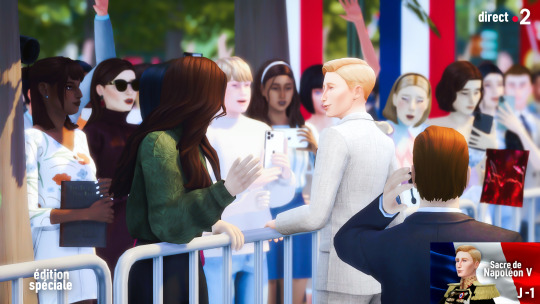
(Stéphane Bernard) This is an exercise rarely undertaken by the French imperial family. In truth, few could have imagined that this ceremony would take place on the occasion of the coronation, especially considering the recent turmoil. However, His Majesty is determined to deliver a powerful message to all his detractors and to strengthen ties with the French people.
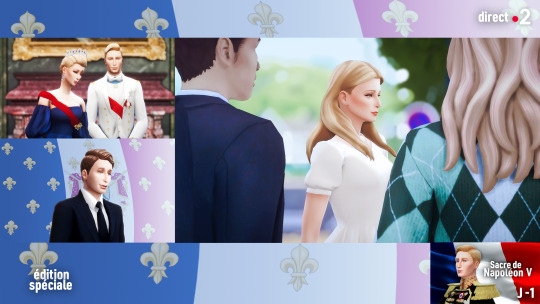
(Stéphane Bernard) Emperor Napoleon V must establish his style and herald change to win back his people. After the coronation ceremony, will we witness the swearing-in of all the bodies that constitute Francesim, thereby renewing their allegiance to the Emperor? His Majesty must make a successful entrance into his reign and, I believe, in some way, significantly transform Francesim.
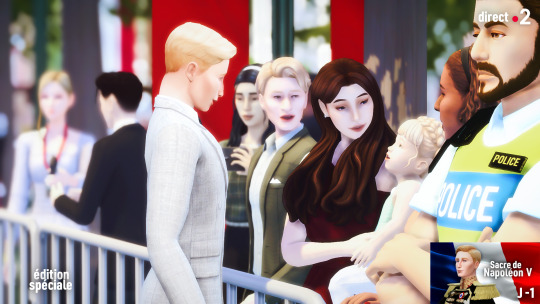
(Stéphane Bernard) He will need to find the right words, gestures of appeasement, and an attitude that will bring about national unity. Many skeptics doubt his abilities due to his young age, barely 19 years old. Yet, this walkabout evokes the image of a thaumaturgic emperor, soothing ailments through direct contact with the people. This, in fact, is one of the foundations of the Napoleonic idea: the Emperor and the People. Of course, thaumaturgy is irrational, and hardly anyone truly believes in it nowadays. Nonetheless, the people display a strong desire to form a connection with this young emperor, in whom they can see themselves.
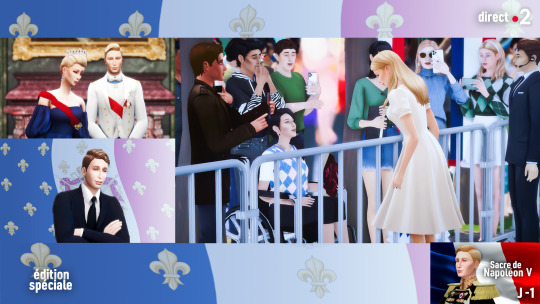
(Another journalist) What do you think, Stéphane, about Empress Charlotte? Will she live up to the role that awaits her? She's only 19 too
(Stéphane Bernard) Empress Charlotte will undoubtedly be an essential pillar for His Majesty Emperor Napoleon V. Already, she enjoys immense popularity among the French. She is a woman of great intellect, full of charm, and remarkable beauty. Strangely, she gives the impression of having always been part of the imperial family. She understands the role: sacrificing her private life on the altar of the monarchy. The couple must now take up the mantle and embody modernity.
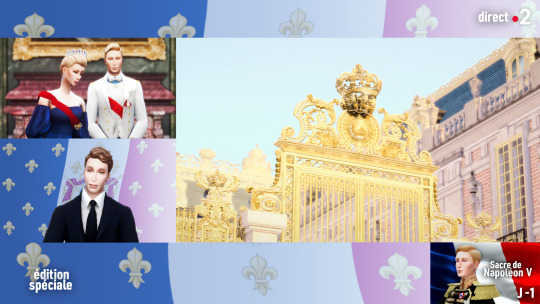
(Stéphane Bernard) On screen, you can see the majestic entrance gate of the Château de Versailles. It is here, in this historic location, that the gala is being prepared, where tonight all the greatest heads of state in the world will be present. Choosing Versailles is not incidental. It is about showcasing French culture and refinement, a heritage to which we are all deeply attached!
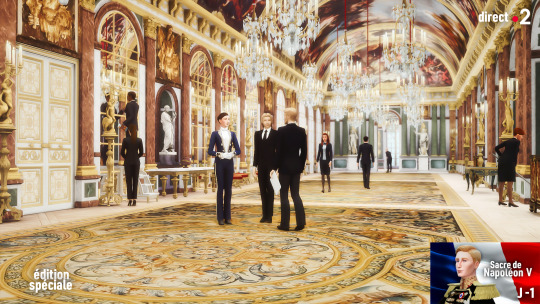
(Stéphane Bernard) A glimpse of the famous Hall of Mirrors where the Imperial Household is preparing for the arrival of the Emperor's guests. It's an unconventional coronation, for several reasons. Tomorrow, Francesim will become the center of the world. The young imperial couple, in the spotlight, will seize this unique moment to assert themselves brilliantly on the diplomatic stage. The Emperor has wished to showcase all the splendor that Francesim is capable of. His Majesty has spared no expense to ensure that these days are truly unforgettable.

(Stéphane Bernard) Allow me to tell you about the regalia, these symbols of power that are currently safely housed in the Palais des Tuileries, in the heart of Paris. They will soon be transported to the cathedral for the grand ceremony. I must confess, I have been preparing for this event for nearly ten years, and like all of you, I am eagerly awaiting the realization of this historic moment!
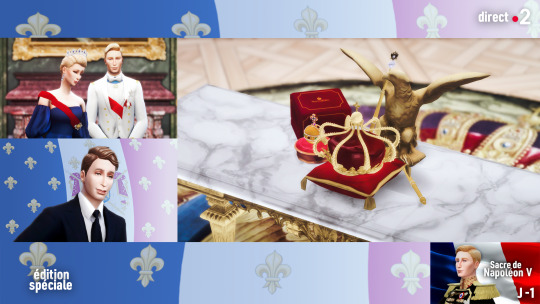
(Other journalist) Isn't a coronation somewhat outdated today? Couldn't it be "simpler", like republican ceremonies?
(Stéphane Bernard) Yes, it's quaint. However, it remains an indispensable rite for the Nation to commune and identify with. In these times of identity retreat, the monarchy provides a path to overcome these divisions. As long as this symbol endures, it will continue to serve as a unifying force – and the Napoléons, better than anyone, have understood this well. Unfortunately, our Presidents of the Republic have never managed to accomplish this mission with the same grandeur.

⚜ Le Sacre de Napoléon V | N°1 | Francesim, Paris, 27 Thermidor An 230
The imperial couple took a walkabout on the eve of the coronation. It was broadcast live on television by Stéphane Bernard, the famous journalist covering crowned heads in Francesim.
Beginning ▬ Previous ▬ Next
⚜ Traduction française
Le bain de foule demeure un exercice fort peu usité par la famille impériale française. En vérité, bien peu parmi nous pouvaient imaginer que ce cérémonial se déroulerait à l'occasion du couronnement, surtout en considérant les tumultes récents. Cependant, Sa Majesté, avec une détermination à toute épreuve, aspire à délivrer un message puissant à tous ses détracteurs et à resserrer les liens avec le peuple français !
L'empereur Napoléon V doit arriver à imprimer son style et à annoncer le changement pour reconquérir son peuple. Après la cérémonie de couronnement, assisterons-nous à la prestation de serment de tous les corps constituant la Francesim, renouvelant ainsi leur allégeance à l'Empereur ? Sa Majesté doit réussir son entrée de règne et, je crois, d'une certaine manière, bouleverser la Francesim de manière significative
Il va devoir avoir les mots, les gestes d'apaisement et d'attitude qui permettront de ramener l'union nationale. Bien des sceptiques doutent de ses capacités en raison de son jeune âge, à peine 19 ans. Pourtant, ce bain de foule évoque l'image d'un empereur thaumaturge, apaisant les maux par le contact direct entre le peuple et le souverain. C'est d'ailleurs, l'un des fondements de l'idée napoléonienne : l'Empereur et le Peuple. Bien sûr, la thaumaturgie relève de l'irrationnel, et plus personne n'y croit réellement de nos jours. Néanmoins, le peuple manifeste un désir ardent de créer un lien avec ce jeune empereur, en qui l'on peut s'identifier
(Autre journaliste) Que pensez-vous Stéphane de l'impératrice Charlotte ? Sera-t-elle à la hauteur du rôle qui l'attend ?
L'impératrice Charlotte sera sans doute un pilier essentiel pour Sa Majesté l'empereur Napoléon V. Déjà, elle jouit d'une popularité immense auprès des Français. C'est une femme d'esprit, pleine de charme et d'une beauté remarquable. Etrangement, elle donne l'impression d'avoir toujours appartenu à la famille impériale. Elle a compris le job : aliéner sa vie privée sur l'autel de la monarchie. Le couple doit désormais prendre la relève et incarner la modernité.
A l'écran, vous voyez le majestueux portail d'entrée du château de Versailles. C'est ici, dans ce lieu historique, que se prépare le gala où seront présents ce soir tous les plus grands chefs d'état du monde. Choisir Versailles n'est pas anodin. Il s'agit de mettre au premier plan la culture et le raffinement à la française, ce patrimoine auquel nous sommes tous si attachés.
Une vue sur la célèbre galerie des glaces où la Maison Impériale prépare l'arrivée des invités de l'Empereur. C'est un couronnement atypique, pour plusieurs raisons. Demain, la Francesim deviendra le centre du monde. Le jeune couple impérial, en pleine lumière, saisira cet instant unique pour s'affirmer avec éclat sur la scène diplomatique. L'empereur a souhaité mettre à l'honneur toute la splendeur dont la Francesim est capable. Sa Majesté n’a pas épargné la moindre dépense pour que ces journées soit véritablement inoubliables
Permettez-moi de vous parler des regalia, ces insignes de pouvoir qui, pour l'instant, reposent en toute sécurité au palais des Tuileries, au cœur de Paris. Ils seront bientôt transportés à la cathédrale pour la grande cérémonie. Je dois vous confier que je me prépare pour cet événement depuis près de dix ans, et comme vous tous, je brûle d'impatience de voir ce moment historique se réaliser !
(Autre journaliste) N'est-ce pas un peu désuet aujourd'hui, un couronnement ? Ca ne pourrait pas être plus "simple" comme les cérémonies républicaines ?
On peut penser qu'un couronnement est une tradition désuète de nos jours. Oui, c'est désuet. Cependant, il s'agit d'un rite indispensable pour permettre à la Nation de communier et de s'identifier. En ces temps de repli identitaire, la monarchie offre une voie pour surmonter ces divisions. Tant que ce symbole perdure, il continuera de jouer son rôle de rassembleur – et les Napoléons, mieux que quiconque, l'ont bien compris. Nos présidents de la République, hélas, n'ont jamais su accomplir cette mission avec la même grandeur.
#simparte#ts4#ts4 royal#royal simblr#sims 4 royal#sim : louis#sims 4#sims 4 fr#ts4 royalty#sims 4 royalty#sim : charlotte#episode iii#coronation napoleon v#ts4 coronation#le cabinet noir#sims 4 royal family#ts4 royal family#ts4 royal simblr#ts4 royals#royal sims#sims royalty#sims royal family
49 notes
·
View notes
Text
• Rose Valland, at the Jeu de Paume museum, colorized by me.
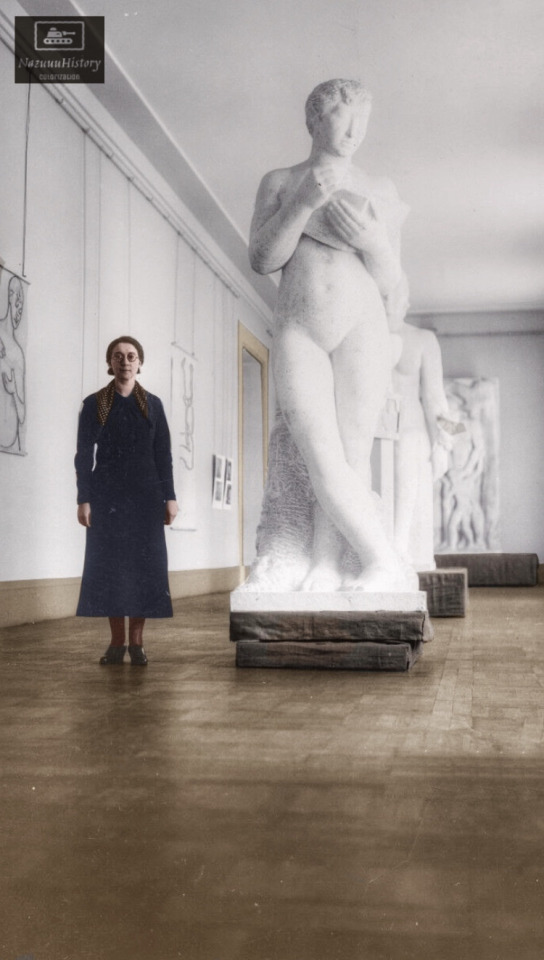
- Rose Valland, whose real name was Rosa Antonia Valland, was born on November 1, 1898 in Saint-Étienne-de-Saint-Geoirs (Isère). In the 1920s, she took art history courses at the École pratique des hautes études, the Ecole du Louvre and the Institut d'Art et d'Archéologie. From 1932, as a volunteer attaché at the Museum of Foreign Paintings and Sculptures at the Galerie nationale du Jeu de Paume in the Tuileries, in Paris, she enriched the catalog of the collections.
From 1940, when the Nazis occupied her museum to store the works looted from Jewish families, she meticulously recorded the list of these first-class trinkets. Her investigations, conducted secretly and at the risk of her life, would lead to the repatriation and restitution of at least 45,000 works.
Finally, she hid several hundred works and informed the resistance fighters of the timetables of trains leaving for Germany, allowing the railway workers to stop the convoys and in particular to save more than 900 paintings by Gauguin, Degas, Modigliani and Renoir as well as 64 works by Picasso.
After the liberation of Paris in 1944, Rose Valland continued her work, helping to find and restore works of art. She was appointed heritage curator and worked for the Commission de récupération artistique (CRA). She also wrote a book, “Le Front de l’art”, published in 1961, which recounts her experiences during the war. She also met Joyce Heer, a secretary-interpreter at the United States Embassy, who became her companion until her death. The two women shared an apartment at 4 rue de Navarre in the 5th arrondissement of Paris. Rose Valland would reserve a place for her next to her in the family vault.
#colorize by me#colorized#world war 2 women#world war two#ww2#ww2 history#ww2 women#world war 2#world war ii#french resistance#french#rose valland
3 notes
·
View notes
Note
Hello! So uh I’m trying to write a musical about Max, but there’s literally so much about him I don’t know how to simplify everything. How would you summarize Max’s life in about 26 bullet points?
Oh boy. That's tricky. But thanks for the ask and props to you for taking on such a big but really cool task! I could absolutely never lol. Hopefully I can help though (This is assuming you want your musical to cover the span of his entire life in the way my book does/did. and is trying to put emphasis on his life during the revolution.) Obviously this list doesn't exhaust all important events in Max's life, but these are the ones I personally believe are most relevant to telling his story and the story of the revolution.
At 6, child Robespierre loses his parents (death and desertion) and moves in with his grandparents. (1764)
Leaves Arras and attends school at Louis-le-Grand in Paris. Friendship with Camille forms. (1769-1781)
Max's law career back home in Arras after graduation. (1781-1789
Estates-General is called to meet. Max is elected as a deputy for the Third Estate of Artois (April 1789)
Estates-general meets. Tennis Court Oath. (May-June 1789)
Storming of the Bastille. (July 14 1789)
Joins the Jacobin club. Meets Danton a few months before. (November 1789)
Elected president of the Jacobin club (March 31 1790)
Louis and the royal family flee Paris. Calls for the deposition of the king to the Jacobins. (June 1791)
Champ de Mars massacre. (July 17 1791)
Max moves in with the Duplays. Begins to establish a close relationship with them. (Late July. Sometime in the aftermath of the massacre.)
Makes speeches against war in the Jacobin club (December 1791)
War is declared on France (June 1792)
Overthrow of the king/storming of the Tuileries. (August 10 1792)
September Massacres (2-6 September 1792)
Elected as deputy to the National Convention. Meets SJ around this time. (Sept 5 1792)
King's trial and execution (January 14-21 1793)
Appointed to the Committee of public safety. Becomes president 2 months later. (July 27 1793)
Camille attacks Max and the government in the Vieux Cordelier. The friendship ends. (Dec 24 1793)
Arrests and executions of the Dantonists (March 13-24 1794)
Assassination attempts (May 23-24 1794)
Festival of the Supreme Being (June 8 1794)
Law of 22 Prairal (June 10 1794)
Speeches before the Convention and the Jacobin Club. Is refused to be heard and arrested.
Events at the Hotel de Ville
Execution
22 notes
·
View notes
Text
Rules: post the names of all the files in your WIP folder regardless of how non-descriptive or ridiculous. Let people send you an ask with the title that most intrigues them and then post a little snippet of it or tell them something about it! And then tag as many people as you have wips. (You can make your own post or reblog this one!) I have deemed that this isn’t just for writing either. Sketch titles? Comics? Dnd campaigns? If you have an unfinished project, it counts!!
Tagged by @drewsaturday
So, my means of categorizing WIPs is....fuck’d. I have a lot of fics that just. Aren’t titled. And very likely won’t be named until I actually am in a position to publish them. So, in those cases, I’ll just post whatever they’re saved with in my WIP folder, which is usually the first line, which will be italicized.
1789
1789 Reincarnation (Peyronan)
The Abomination: Les Amants (Peyronan)
AC Fusion (Crossover with MA) (Peyronan)
“Ah, Ramard,” Artois folded his hands in front of him, the smile on his face not entirely touching his eyes (Artois/Olympe)
Artois POV - PLP
Christmas Special 1/2
Christmas Special 2/2
Christmas, December 1789
Curl of Lip, Swirl of Gown (Peyronan)
Disneyworld AU
Fairy Tale (Peyronan)
Le Temps s’en va (Peyronan)
Peyrol Olympe Louise Ruin Artois’ Life
Peyronan Father Killing Angst
Peyronan Wedding Night
Pour la Peine (Solène/Olympe)
Olympe POV
Ronan Lives AU (Peyronan)
Solympe Forgiveness Sequel
They crossed the Tuileries, and the Rebels didn’t stir, still set into their insolence like the statues that dotted the gardens, who loomed like judgmental ghosts (Peyronan)
“Wait…Ronan,” Lazare said, and Ronan found himself stopping in his tracks, halfway to the door (Peyronan)
Vampire Ronan AU
Vampire Peyronan
Aladdin
Jaladdin
Jaladdin 2
Arthuriana
Sassy Mordred
St. George and the Dragon (Mordred/Galahad)
Fable
Fable II
“I’m dying, Reaver.” Her eyes bored into his, black and sharp.
Irish Mythology
Bres/Sreng Reincarnation
Claeg
Emer Leave Cú Chulainn’s Unworthy Ass
Ferdiad Lives
Happy St. Patrick’s Day
How did Magh Muirthemne come by its name? (The Dagda/Spoilers)
Modern Bres/Sreng
Sreng knew that there was something wrong when he opened the flat door and Bres didn’t greet him.
Mabinogi
There are moments, when her mind is between straw and silk, when she wonders whether she did do it
Marie Antoinette
Assassin’s Creed AU (Morléans)
Bookshop AU (Morléans)
A Brace of Snakes (Morléans)
ghost one shot
Morléans Coachman
Morléans Couples Counseling
Morléans Ghost Angst
Morléans Reincarnation
Orléans Wins AU
Philippe Lives (Morléans)
Pride and Prejudice and Princes (Morléans)
Someone has to die that day (Morléans, with MA/Fersen and gen dynamics)
“We can’t keep doing this” (Morléans)
Resident Evil
Door #2 (Wintersberg)
Luiza had said it herself (Wintersberg)
Romeo et Juliette
Escaliet
They hadn’t survived the Great Explosion by cowering, or by crying, but by moving onward, and it was how they had kept Verona running for three hundred years (Benvolio/Escalus)
The Tempest
Tempest wtf
Valhalla
Eivor Kingfucker
It only seemed fitting that, when she left Sciropescire, Ivarr’s life-blood staining calloused hands, it began to rain
Misc.
What am I doing?
Lady Bess
Jane Seymour
Look...I could tag people, but I don’t want to count that many and I don’t know if I actually *know* that many people, so if you see this, consider yourself tagged. Yes, even *you*.
4 notes
·
View notes
Text
Experience the Magic of Paris in Spring: A Comprehensive Guide
As winter loosens its grip on Paris, the city awakens to the gentle embrace of spring. From the vibrant blooms adorning its streets to the bustling energy of its cafés, Paris in springtime is a spectacle to behold. Let’s delve into a detailed guide to help you navigate and immerse yourself in the wonders of this enchanting season.
Choosing the perfect accommodation is essential for a memorable Parisian experience. Consider the historical charm of Le Marais, where cobblestone streets lead to hidden boutiques and quaint cafés. Alternatively, indulge in the elegance of a hotel with panoramic views of the Eiffel Tower or opt for a centrally located gem near iconic landmarks like the Louvre.
Enhance your Parisian adventure with an array of curated tours and experiences. Skip the queues at renowned attractions such as the Louvre Museum and ascend to the summit of the Eiffel Tower for panoramic vistas of the city. Explore Paris’ diverse neighborhoods with guided walking tours or embark on a leisurely cruise along the Seine River, where historic landmarks unfold before your eyes.
Stay informed about Paris’ springtime events to make the most of your visit. From Easter celebrations to school holidays and national observances, plan your itinerary accordingly to avoid crowds and maximize your enjoyment. Consider booking tickets in advance for popular attractions and tours to secure your spot and streamline your experience.
Immerse yourself in the quintessential Parisian experience by indulging in the city’s cultural and culinary delights. Spend leisurely afternoons at sidewalk cafés, sipping espresso and people-watching amidst the bustling streets. Explore the tranquil beauty of Paris’ gardens, from the iconic Tuileries to the charming Luxembourg Gardens, where blooming flowers and manicured lawns beckon you to linger.
Witness Paris come to life with the arrival of spring blooms, from delicate cherry blossoms to vibrant tulips and daffodils. Stroll through the city’s parks and gardens, where bursts of color adorn every corner, creating a picturesque backdrop for your adventures. Don’t miss the opportunity to visit the Marché aux Fleurs on the Île de la Cité, where you can immerse yourself in the sights and scents of seasonal flowers.
Savor the flavors of spring with Paris’ culinary offerings, from fresh produce sourced from local markets to artisanal breads celebrated during La Fête du Pain. Explore open-air markets like Marché Aligre or Marché Place des Fêtes, where you can sample seasonal delicacies and immerse yourself in the vibrant atmosphere of Parisian life.
As you embark on your journey through Paris in springtime, let yourself be captivated by the city’s timeless beauty and vibrant energy. Each new discovery and delightful experience, you’ll create cherished memories that will linger long after you bid adieu to the City of Light. So pack your bags, embrace the spirit of adventure, and immerse yourself in the magic of Paris in spring.
1 note
·
View note
Text
proof B part 03
https://www.valeursactuelles.com/societe/pedophilie-au-maroc-les-revelations-choc-dun-ex-amant-de-berge-et-saint-laurent
https://www-valeursactuelles-com.translate.goog/societe/pedophilie-au-maroc-les-revelations-choc-dun-ex-amant-de-berge-et-saint-laurent?_x_tr_sl=fr&_x_tr_tl=en&_x_tr_hl=en-US&_x_tr_pto=wapp
Pedophilia in Morocco: the shocking revelations of an ex-lover of Bergé and Saint-Laurent
Scandal. Fabrice Thomas claims, in a nauseating book, to have witnessed an illegal act in the couple's villa in Marrakech. A scene which did not shock the designer at the time.
In his book “Saint Laurent and me: an intimate story” (Hugo Document), published on October 12, Fabrice Thomas, who was the lover of the famous fashion designer Yves Saint-Laurent and his pygmalion Pierre Bergé, reveals the dark side of infernal couple, “two icons, two exceptional men, but two sexually ill men” , as he describes them in an interview with the Canadian channel TVA Nouvelles , broadcast on October 27.
“Eight years, from 1984 to 1992, my life with Yves Saint Laurent and Pierre Bergé resembled a whirlwind,” writes Fabrice Thomas, who was the driver of the boss of the fashion house, then of the designer, with with whom he had a three-year affair. Above all, a descent into hell, punctuated by violent and extreme sexual practices. “I had been Pierre's sexual object and I had become Yves' dominating lover. I had gone from one to the other, from one side to the other of the whip, but I was still in between,” he sums up.
“His libidinal power was impressive”
“Pierre, (…), thanks to the free-thinking of his anarchist, educated and rebellious parents, had always experienced his homosexuality as one form of sexuality among others, without guilt or hindrance”, explains the author, hired by the fashion group after stopping by their room at the Plaza Athénée. But gradually, his “sadistic passion” takes over.
“His libidinal power was impressive. For my part, I knew its destructive side well. It deeply affected Yves ,” emphasizes Fabrice Thomas. “From there, I joined his cohort of lovers subjected to training sessions which then became the norm between us, until 1989 when I put an end to it.” The author, on a leash and on all fours, thus recounts a scene, where Bergé, known as “Monsieur”, slapped him, whipped him bloody and attached adjustable clamps to his nipples, before urinating on him, in insulting him, drugging him with “poppers” and watching porn films with his assistant .
When he is not driving the founder of the YSL house during the day, Fabrice Thomas escorts the drugged couturier in his crazy outfits at night. “Yves was a sexual prey. This is what he liked to be, his sexual preferences leading him to immoderate submission,” he says. “He operated in the same way with Pierre during their life together. He would slip out the window of his room to go and have fun on the quays and in the parks where he would 'sew buttons' on a few Moroccans or Algerians who asked for nothing better than to receive a few francs for this service for which they would have paid for it themselves.”
The “young men” of the Majorelle Garden
Fabrice Thomas also accompanies Saint-Laurent to his villa in Marrakech, Morocco, where he and Bergé bought the Majorelle Gardens in 1985. Andy Warhol, the Rolling Stones and Catherine Deneuve will parade there. The Oasis villa is “ a sexual resort, one more, for him and for Pierre Bergé,” he writes. Regarding sex tourism, popular at the time among many artists, the author specifies that “Yves and Pierre were not tourists, they had developed ongoing, even friendly, relationships with some of their young lovers. .”
One scene, described in the book, even relates an act of pedophilia. Yves Saint-Laurent has gotten into the habit of welcoming “young men” who present themselves at the garden gate. “The bamboo grove is the Tuileries of Marrakech,” he jokes. A gay meeting place. “I saw men pass there, foreigners and locals, of all ages. Until the day I saw the unthinkable ,” says Fabrice Thomas, seized by anger and rage. “The steward kneeling before a prepubescent teenager standing before him, naked as a worm. Holding his buttocks with both palms, he eagerly sucked the child who was letting himself do so while looking up, holding a note in his hand.”
“Is this kind of thing tolerated?” he asked the designer that same evening. “Oh… In the palm grove, there’s a lot more going on. The authorities prefer to act as if they do not know. And yet, everyone knows, obviously.” Frightened, Fabrice Thomas insists: “But there, it’s happening at home! It’s one of your employees who’s doing that with a kid…” Saint-Laurent’s response: “Not at my place, no. The Majorelle Garden is public.” In his book Letters to Yves (Gallimard), Pierre Bergé also remembered: “How kind and beautiful they were, these Moroccan boys! They all played football, had muscular bodies. We had relationships with them that smacked of neither money nor vulgarity.”
Pierre Bergé: “I am not a pedophile”
Until now, no witness has been able to confirm the rumor. In May 2011, Luc Ferry accused, without naming him, a former French minister of having engaged in pedophilia in Morocco. Two years later, an investigation report, revealed by VSD in March, mentioned a French priest who had stayed in Morocco, who reported cases of “prostitution of minors at the Villa Majorelle”. The clergyman told the magazine: “In the medina, parents of young victims confided in me.”
At the time, Bergé categorically denied: “I am not a pedophile. I have never organized orgies in my house in Marrakech. Now prove the opposite instead of talking nonsense.” The case has since been closed. Bergé and Saint-Laurent were never prosecuted. In November 2016, the businessman and companion of Yves Saint Laurent who died in 2008, added in the program “Stupéfiant!”, broadcast on France 2: “ Morals were freer than today, especially in Morocco. At the time, sexuality was more unbridled, we paid less attention to it.”
An assassination attempt
In his book, Fabrice Thomas makes other confidences about Saint-Laurent. “I remembered that he had told me, strangely quite pleased with himself, that he had tried to assassinate Pierre Bergé with a ten-kilo bronze,” he says. He also notes that the “mascot of the so-called caviar left” who became president of Sidaction, “did not protect himself at all” like Saint-Laurent. Today, Fabrice Thomas is married and lives in Quebec. Pierre Bergé died on September 8, at the age of 86. The former shareholder of Le Monde and godfather of the left, who supported presidential candidate Emmanuel Macron, is now resting in the Majorelle Gardens, alongside his companion Yves Saint-Laurent.
https://archive.ph/qzUf0https://archive.ph/wip/qNEI6
Why don't you talk about the serious accusations of pedophilia targeting Pierre Bergé?
Question asked by 05/11/2017
Good morning,
To our knowledge, there is strictly speaking no accusation of pedophilia against Pierre Bergé. The businessman, who died last September, has been cited twice in recent years in cases of pedophilia but indirectly: as the owner of a villa in Marrakech where acts of pedophilia allegedly took place (not being him imputed).
Current values devoted an article last week to the work of Fabrice Thomas, “Saint Laurent and me: an intimate story” , published on October 12. Fabrice Thomas, who presents himself as the former lover of Yves Saint-Laurent and Pierre Bergé, describes the couple's sexual intimacy. During the promotional campaign for his book, the author notably stated in an interview on Canadian television “Dominique Strauss-Kahn or Harvey Weinstein, believe me, next to Pierre Bergé they are altar boys.” The author describes sadomasochistic sexual games, affirms that Pierre Bergé had "sex slaves" but does not accuse him of any act of pedophilia. If there is talk of pedophilia in the book (and in the article in Valeurs nationaux), this does not concern the former shareholder of Le Monde. Fabrice Thomas relates a scene of pedophilia involving the steward of the Jardin Majorelle villa, owned by Yves Saint Laurent and Pierre Bergé in Marrakech. Fabrice Thomas writes a dialogue during which he would have been moved by the facts unfolding before his eyes: "But here, it's happening at your house! It's one of your employees who is doing this with a kid…" Saint-Laurent's response: “Not at my place, no. The Majorelle Garden is public.” The name of Pierre Bergé is not mentioned in this extract.
Pierre Bergé was cited in VSD in 2013, again indirectly, and still as the owner of the villa in Marrakech. On May 30, 2011, Luc Ferry claimed on the Canal + set that a former minister was “stuck in Marrakech in an orgy with little boys” and that this scandal would have been hushed up. Comments which led to the opening of two investigations. One, in Morocco, the other, in France, entrusted by the Paris prosecutor's office to the juvenile brigade. Libération reported on the progress of the latter in 2011 ). The investigation was dismissed in November 2012. A few months later, in March 2013, VSD, based on the investigation file, and despite the dismissal of the investigation, published the comments of a priest from the south of France claiming to have collected between 2003 and 2007 testimonies attesting to acts of "prostitution of minors at the Villa Majorelle, property of Yves Saint Laurent and Pierre Bergé, where Jack Lang was regularly invited" . VSD specifies that the "witness "did not give any name" . This is the only passage in the VSD article where the name of Pierre Bergé is mentioned.
In 2014, the conspiracy site Panamza took up the testimony of the priest cited by VSD, in an article heavy with innuendo, and received a complaint for defamation. Pierre Bergé also attacks the sites FDesouche or Riposte laïque for having relayed the Panamza article. The defamation trial was to be held in the fall of 2017. It was not held due to the death of Pierre Bergé, which occurred on September 8, 2017.
A little less than a year earlier, in November 2016, Pierre Bergé addressed these questions in an interview with Léa Salamé, filmed in his Moroccan villa. He had refuted the rumors of pedophilia concerning him, while recognizing, in the name of "free sexuality", having had relations with "Moroccan boys" , at a time when "morals were freer" .
Pierre Bergé: "There was a particular form of sensuality, I can confirm it. Morals were freer than today. Sexuality was more unbridled and we paid less attention to it. But we must not exaggerate, when in tweets They say that I had orgies with Jack Lang, with little boys, I wouldn't even have wanted to because I don't like little boys. That wasn't the story.
Léa Salamé: You write in Lettres à Yves (published by Gallimard, editor's note) : "how nice and handsome these Moroccan boys were. They played football, they had muscular bodies. We had a relationship with them that neither smelled nor "money nor vulgarity".
Pierre Bergé: "It's true, I knew a lot of them. They became, not friends, but very pleasant relationships. We drank mint tea, they invited us to lunch with their family. This n It wasn't prostitution, there was probably prostitution, but I don't have a great taste for sex tourism.
Léa Salamé: Okay, so it was just a free way of experiencing your sexuality?
Pierre Bergé: “yes, a way of experiencing your sexuality”
There are therefore no accusations directly targeting Pierre Bergé. And the accusations relating to events that took place in his house were not the subject of direct testimony from the victims, nor of complaints.
It should also be remembered that an indirect accusation, or a rumor, is not enough to create information. And also that in matters of press law, the fact of relaying a defamatory statement is sufficient to characterize defamation. A newspaper, to relay accusations, must provide additional investigative elements, contradiction, demonstrate balanced treatment, etc. Libération, to date, has no evidence justifying the publication of an investigation on the subject.
Since the Weinstein affair, Libération has launched several investigations into sexual harassment. A first was published about the BNP. A second is awaiting publication, and concerns world politics.
Sincerely
C.Mt
https://archive.ph/wip/5UE18
PARIS — Gabriel Matzneff was a celebrated writer with a coterie of powerful friends, including fashion designer Yves St. Laurent and former President François Mitterrand, who once described Matzneff as a “mix of Dorian Gray and Dracula.”
That the French writer had a pedophile past was a secret to nobody. He wrote about his penchant for sex with children for years. He discussed it openly on television. He was reported to the police for sexual abuse decades ago but was never investigated, even as he challenged bourgeois taboos and collected a stipend from the Ministry of Culture.
“To sleep with a child, it’s a holy experience, a baptismal event, a sacred adventure,” he wrote in his 1974 book “Les Moins de Seize Ans” (“The Under Sixteens”). He went further in his 1985 diaries — “Un Galop d’Enfer” (“A Hellish Gallop”) — writing of his visits to the Philippines: “Sometimes, I’ll have as many as four boys, from eight to 14 years old, in my bed at the same time.”
In her book “Le Consentement” (“Consent”), Vanessa Springora alleges that she had a destructive underage sexual relationship with French writer Gabriel Matzneff.
In “Le Consentement” (“Consent”), Vanessa Springora, now 47, claims she was groomed by Matzneff when she was a girl. She recounts a life of confusion and conflicted feelings that perhaps she had consented to the relationship and must be blamed. She writes of psychological devastation and of having no understanding that she was a victim until she was an adult.
That Matzneff wrote about their relationship in his books, long after it had ended, served as a recurring reminder of what Springora came to see for what it was: abuse.
“As if his passing through my life hadn’t been devastating enough,” Springora writes, “he had to continue documenting, falsifying, recording and forever engraving his misdeeds.”
The statute of limitations has run out for Matzneff to be charged with sexually abusing Springora. But the Paris public prosecutor has opened an investigation into his sexual past and asked for potential victims and witnesses to come forward. In a separate case, brought by a victims network organization, a Paris court has set a trial date in September on allegations that Matzneff’s work is an “apology for pedophilia.”
The 83-year-old Matzneff could not be reached for comment. A French TV company recently tracked him down on the Italian coast. He described his relationship with the underage Springora as a love affair. “I don’t want to read her book,” he told BFMTV. “We were happy together. I have marvelous memories. We lived a lasting and marvelous love story.”
“When you publish something it is a public confession,” he said. “That’s what writers do, that’s why writers are the first to be shot because they leave written traces. They write, they confess their sins. At that time nobody thought of the law. We did things that weren’t allowed … nobody spoke of a crime at that time.”
The story has reverberated beyond legal circles to the heart of France’s intellectual class. Springora heads a prestigious publishing house and travels in many of the same circles as Matzneff.
Mehana Mouhou, an attorney involved in a lawsuit against French writer Gabriel Matzneff, speaks to the media outside court in Paris on Feb. 12, 2020.
“The French justice system has prostrated itself before a writer,” said Mehana Mouhou, a lawyer involved in the suit against the author. “Matzneff never hid what he did. He recounted the relations he had with young children whose lives have been shattered and scarred. Ministers, people in the world of culture, politics, the media, let it go and and now we have to ask why they let it go and seek accomplices. Matzneff is just the tip of an iceberg.”
The essence of Matzneff’s defense is that his sexual relations with children happened in a liberal, laissez-faire era before the #MeToo movement and other societal shifts that have changed sexual attitudes. He references a moment when famous writers including Michel Foucault, Jean-Paul Sartre and Simone de Beauvoir and respected newspapers, notably Libération and Le Monde, defended the idea that sex with minors was a form of liberation for both parties.
“There were all these arguments [in the ’70s and ’80s] that the child was a person in their own right, that they were fully formed at age 6 and that the family was a prison from which the child had to be liberated,” said Pierre Verdrager, a French sociologist and expert in the history of pedophilia. “These people argued that sexual relations with an adult were a form of emancipation, and that parents who complained that their child had been abused were only interested in getting money in damages.”
Matzneff benefited from the cover of the culture’s libertine sentiments. During a 1970s television show, he was questioned about his desire for schoolgirls by the Canadian writer Denise Bombardier, who said his actions disgusted her. The next day the French writer Jacques Lanzmann suggested someone should have slapped Bombardier for her rudeness.
France had no age of “consent” until 2018. Since World War II, the age where sexual relations can be considered legal — known as the age of “sexual majority” — has always been 15. However, Verdrager said the question of whether children under that age can consent to sexual relations with an adult is a gray area.
“In the 1980s there was a very strong movement for the lowering of the sexual majority to 13 or 14 and then progressively getting rid of it altogether,” said Verdrager. “The people who supported this cited Greek mythology and historical traditions to support their ideas.”
French identity is entwined with reverence for culture. Literature, cinema and theater are seen as beacons of enlightenment in a philistine world. Government policy for more than half a century supported and defended this idea, giving rise to the expression “l’exception culturelle française”: the French cultural exception.
Books are published because they are considered artistically worthy, not profitable. Sales of Matzneff’s books could be counted more in the hundreds than in the tens of thousands.
But artists, writers, directors, actors like him are regarded with a certain awe. France and Switzerland have refused to extradite the Polish-French film director Roman Polanski, wanted in the U.S. after pleading guilty to unlawful sex with a 13-year-old girl in 1978. French writers and artists argue that Polanski’s work transcends what many outside the intelligentsia regard as moral failings.
This aura feeds into the French idea of “seduction,” which has less to do with sex and is more a mix of allure, promise and charm.
In 2011, Dominique Strauss-Kahn, the man who would have been France’s next president, was arrested in New York and charged with sexual assault and attempted rape of a hotel maid — charges later dismissed though Strauss-Kahn settled a civil suit for around $1.5 million.
Public figures rose to his defense, describing the then chief of the International Monetary Fund as an inveterate seducer of women and a “brilliant economist.” One French magazine editor said Strauss-Kahn was guilty of nothing more than “un troussage de domestique,” the idea that the master can have his way with a servant girl.
Actress Catherine Deneuve is among 100 French women denouncing the “puritanical wave” of the #MeToo movement.
These sentiments were shaken in 2018 after revelations against Harvey Weinstein, which propelled a #MeToo movement in France. French feminists hailed a long overdue rejection of the idea that seduction à la Strauss-Kahn was acceptable. But not everyone agreed. One hundred French women, including actress Catherine Deneuve and libertine writer Catherine Millet, signed an open letter defending men’s “freedom to bother women,” which they said was “indispensable to sexual freedom.” The letter was seen as a repudiation of Anglo-Saxon morality and puritanism.
But the Matzneff Affair, as it is now known, is set to recast the liberties extended to writers.
Asked how Matzneff was able to operate openly as a pedophile, Bernard Pivot, a well-known French literary critic and journalist who has interviewed the writer many times, said: “In the 1970s and 1980s, literature came before morality; today, morality comes before literature. Morally, that’s progress. We’re all more or less the intellectual and moral products of a country and, above all, an era.”
Latifa Bennari, the founder and president of the Blue Angel Assn., a support network for victims of pedophilia and for those with pedophilic inclinations, has brought a lawsuit against Matzneff for “glorifying pedophilia.” She says some men who were struggling to control their sexual urges were given a green light to abuse minors by Matzneff’s work.
“He wasn’t fantasizing, he actually did these things and he wrote about them,” said Bennari. “I don’t understand how anyone could have closed their eyes to this. They say it was a different era, but pedophilia was never acceptable.”
The lawsuit was filed in a Paris court this month and will have full hearing in September. A criminal investigation is also underway. Police have raided the offices of Matzneff’s publisher, Gallimard, for unexpurgated manuscripts. But it could take years before a criminal case comes to trial.
“My aim is to bring Matzneff to justice for the first time in his life,” said Mouhou, the lawyer representing Blue Angel Assn. in its lawsuit. “The crime of promoting pedophilia is five years’ imprisonment, and that is what I seek.
“What Matzneff has done is to incite pedophiles to act. That is a crime. It’s a scandal for French society and the French justice system. The public prosecutor could have brought a case against him, but for a long time they did nothing. He published books vaunting pedophilia as if it was art and literature when in fact it was a crime.”
https://archive.is/mGRlH
#yves saint laurent#saint laurent#pierre berge#fabrice thomas#jessica moloney#jess moloney#jamie campbell bower#jamie bower#fashiongate
0 notes
Text
Best Way To Explore Paris
Exploring Paris, often called the "City of Light," can be a wonderful and memorable experience. To make the most of your trip, consider these tips and recommendations:
Plan Ahead: Research the top attractions, neighborhoods, and activities in Paris before your trip. Create a rough itinerary to ensure you don't miss out on any must-see places.
Stay in a Central Location: Choose accommodations in a central neighborhood like Le Marais, Saint-Germain-des-Prés, or the Latin Quarter. This will make it easier to access many attractions by walking or using public transportation.
Use Public Transportation: Paris has an extensive and efficient public transportation system, including the metro, buses, and trams. Purchase a Paris Visite pass or a Navigo card for unlimited travel on public transport during your stay.
Visit Iconic Landmarks: Don't miss iconic sites such as the Eiffel Tower, Louvre Museum, Notre-Dame Cathedral (currently under renovation), and Sacré-Cœur Basilica. Consider booking tickets in advance to skip the lines.
Explore Neighborhoods: Each Parisian neighborhood has its own unique charm. Wander through Montmartre for artistic vibes, Le Marais for its historic streets, and Champs-Élysées for luxury shopping.
Cruise the Seine River: Take a leisurely boat cruise along the Seine River to enjoy stunning views of landmarks like the Eiffel Tower, Louvre, and Musée d'Orsay from the water.
Savor French Cuisine: Indulge in the city's renowned culinary scene. Try classic dishes like croissants, escargot, coq au vin, and crème brûlée at local cafes and bistros. Don't forget to try authentic French pastries!
Visit Museums and Galleries: In addition to the Louvre, explore other art and cultural institutions like Musée d'Orsay, Centre Pompidou, and Musée de l'Orangerie.
Picnic in Parks: Paris boasts beautiful parks like Luxembourg Gardens and Tuileries Garden. Pack a picnic, relax, and people-watch in these green oases.
Local Markets: Visit open-air markets like Marché Bastille or Rue Cler for a taste of local life. Pick up fresh produce, cheeses, and other delicacies.
Explore Hidden Gems: Venture off the beaten path to discover lesser-known attractions like Canal Saint-Martin or the charming village of Montmartre.
Art and Culture: Enjoy live performances at venues like Opéra Garnier or catch a cabaret show at the famous Moulin Rouge.
Bike Tours: Consider joining a bike tour to explore the city's streets and landmarks at a leisurely pace.
Shop Like a Local: Shop at boutiques and vintage stores in trendy neighborhoods for unique fashion finds.
Learn Basic French Phrases: While many Parisians speak English, learning a few basic French phrases can enhance your experience and show your appreciation for the local culture.
Remember to immerse yourself in the city's atmosphere, take leisurely strolls, and soak in the art, history, and romance that Paris has to offer. Bon voyage!
0 notes
Text

Ivan (Jean) Peske "Family Idyll"
The first third of the XX century. Oil on canvas.
July 27, 1870 (village of Colt/Golta, Kherson province) - March 21, 1949 (Le Mans, Sartha department)
From a Polish family. He spent his young years in Russia. He studied at a gymnasium in Kiev, then at the Odessa Art School (1885-1888); he was friends with O. E. Braz and D. I. Vidhof.
He has lived in Paris since 1889. He studied at the Academy of R. Julien at J.-P. Laurent. He was married to the artist Ekaterina Lushnikova (Lushnikova-Peske, since 1901). In 1921 he received French citizenship.
Since 1891 he was a member of the circle of employees of La Revue Blanche magazine, met A. Toulouse-Latrec and P. Sinyak, members of the Nabi group - P. Seryuzier, M. Denis, P. Bonnar. He became interested in pointillism. In 1902-1911 he worked in the open air in Barbison near Paris. He made friends with K. P. Kuznetsov.s.
He painted impressionistic landscapes of Brittany, southern France, still lifes, nude nature. He was engaged in etching, lithography. In 1901, he held a solo exhibition at La Revue Blanche magazine. Exhibited in salons: Autumn, Independent, Tuileries, National Society of Fine Arts. Participant of various group exhibitions. Presented etchings in the "Art of the Book" pavilion at the International Exhibition of Decorative Arts in Paris (1925). He held solo exhibitions in the Durand-Ruel (1923, 1940) and Saint-Placide (1948) galleries. Participated in the Autumn Salon (1940-1949), the Salon of Independents (1941-1944).
Vellum
1 note
·
View note
Text
Finding my Paris routine
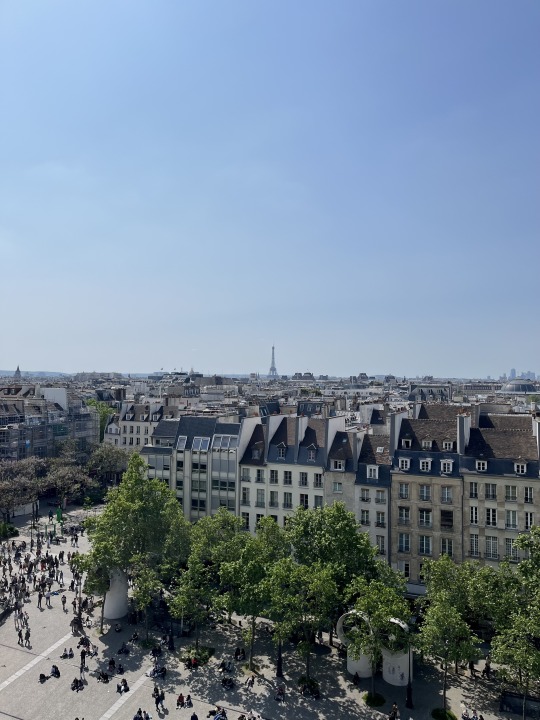
My summer routine back home typically consists of waking up around 10 a.m., the occasional coffee or Target run, heading to work, and watching Criminal Minds before bed (very eventful, I know). Coming to Paris, I knew my routine would not nearly be the same. Upon arrival it was essential I find my Paris routine.
One fairly smooth plane ride later, my friends (who had been on the same flight) and I were transported to local housing, where we faced the looming challenge of discovering how we were going to live for the next 6 weeks. The three of us were housed in studios, one friend in a single and the other friend and I in a double, one of the options included in the program fee. After a few days I will say that I highly recommend the studio—it is relatively spacious and comes with nearly everything one could need: 2 beds, 2 desks, a closet, a kitchenette, and our own bathroom. The only stipulation is that you must provide your own food, which I don’t mind because I feel it contributes to the experience of ‘living as a local,’ per se.


It therefore follows that the first part of the routine we had to establish upon arrival was our weekly shopping trips. Our studio being in the 20th arrondissement, the easternmost district of Paris quite some distance from its most ‘touristy’ areas, our local supermarché Franprix made a quick and reasonably priced choice for our first shopping trip. Now that we’ve stocked up on all the essentials—pasta, bread, eggs, cheese, fruits, and veggies—cooking for one another has become a fun way to avoid the costs of constantly eating out.


It was not until the start of class two days upon arrival that we truly began to establish a daily routine. For myself and both friends, Calculus 3 from 12:30-2:30 p.m. forced us to begin to structure our days into the ‘time before’ and the ‘time after’ class. Additionally, with classes housed at our partner program’s academic building an approximately 45-minute (walk + metro) trip from our studio, we had little to no choice but to invest in a metro pass to make this commute feasible. The cheapest and simplest option for the number of weeks it would be in use ended up being the monthly pass, which has already provided for plenty of exploring during our free time.

The ‘time before’ class has now begun to consist of quick café or boulangerie stops during the walking part of our journey, a little pick-me-up before the two hours of math to follow. The ‘time after’ has been filled with larger and lengthier trips: museums, sightseeing, you name it!


Here are a couple of my favorite stops from this week:
-Starbucks Opéra, the first Parisian Starbucks, housed in a beautiful building over 3 centuries old!
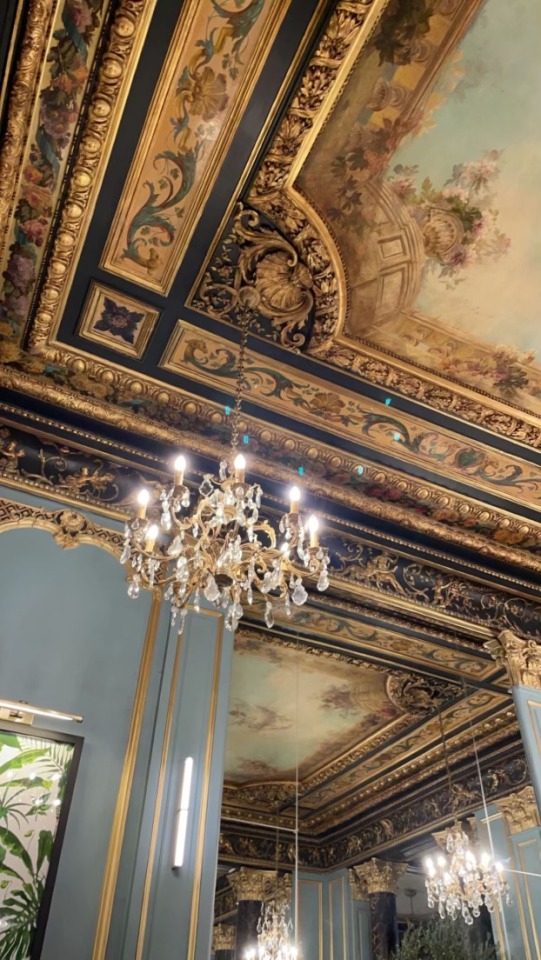

-Le Centre Pompidou, Paris’ one-of-a-kind modern art museum

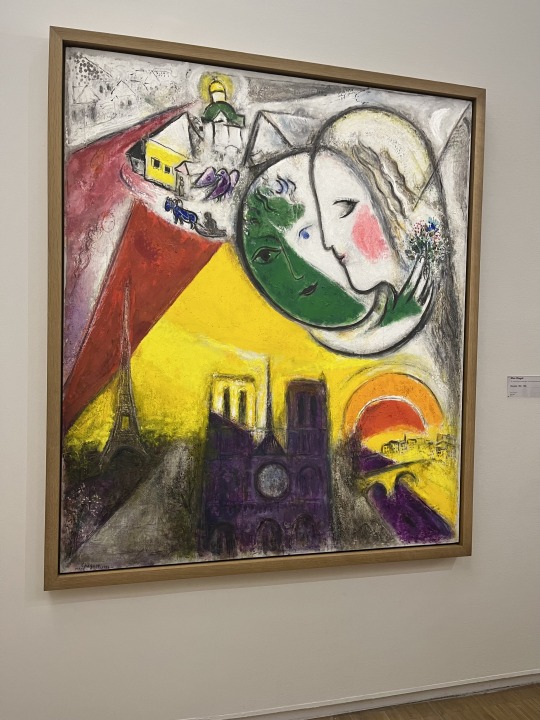
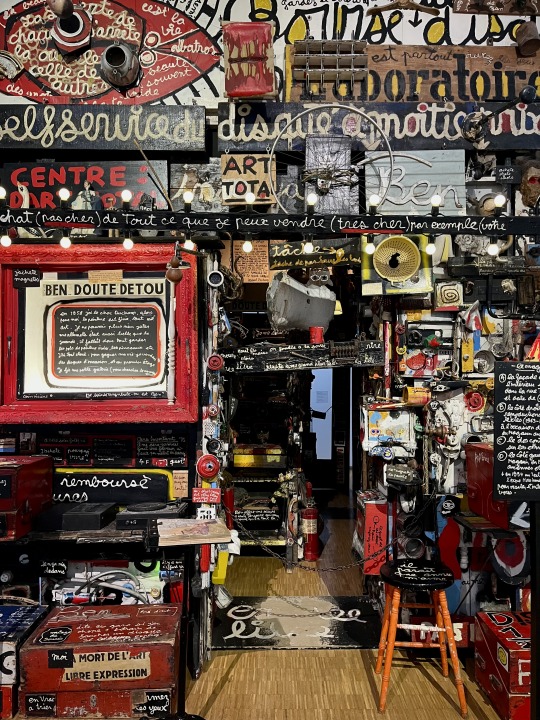
-Le Petit Prince store, filled with all sorts of souvenirs inspired by Antoine de Saint-Exupéry’s most famous book
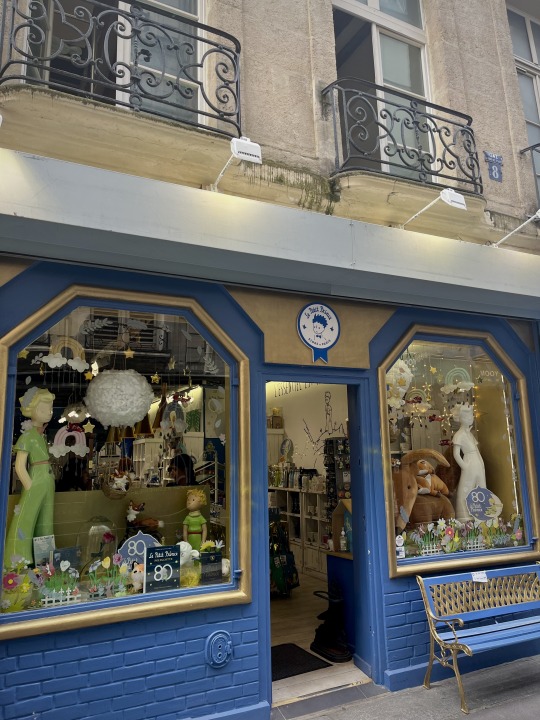
-And of course, La Tour Eiffel!!!


My first weekend in Paris allowed for a bit of break from routine and for more free time to simply do, well, whatever we wanted! As for my friends and I, this was enjoying a restful Saturday followed by a busy Sunday enjoying the beautiful weather and city.
Some weekend highlights:
-Brunch (and the cutest cappuccino) at Sunday in Soho, located in Paris’ 2nd arrondissement


-Visit to le Jardin des Tuileries and le Jardin du Luxembourg (weather was PERFECT for this!)

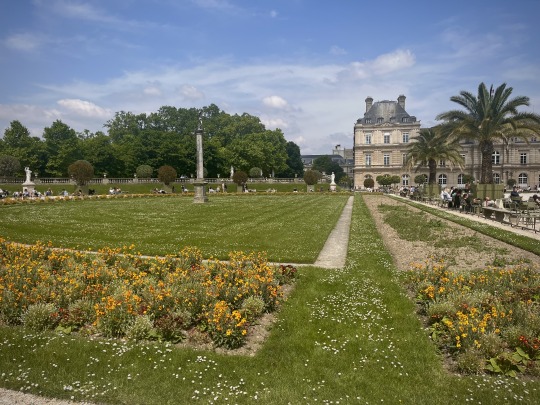
-Dior Galerie, providing a fantastic look into the history of one of the city’s most famous designers
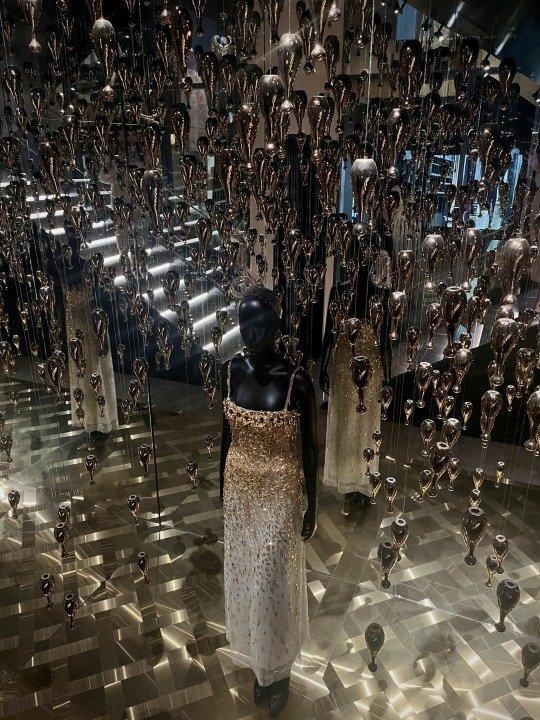
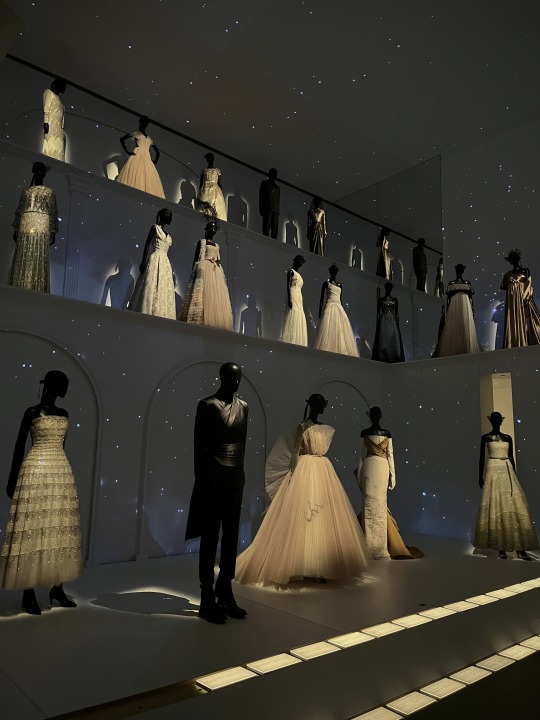
Despite having left some room for spontaneity, having established somewhat of a routine over the course of my first week in Paris has helped me to feel at ease during my transition to life in another country and all the more eager to take on what is to come. I cannot wait to share the rest of my adventures with you!
À tout !!!
Hannah Bernardi
First-year Engineering
Engineering in Paris, France
1 note
·
View note
Text
48 Hours in Paris: A Guide to the Best Places to Eat, Sleep, and Explore
For those with 48 hours in the city of light, we have devised the ideal itinerary beyond the Eiffel Tower and the Arc de Triomphe de la Défense. Within 48 hours, it is possible to conceal the Moulin Rouge, pistachio croissants, and patisseries.

Day 1
Petit Versailles du Marais
Travel back in time by visiting the historic Parisian boulangerie, patisserie, and tea saloon Diamond State thé (tearoom). Its ceilings are tiled and adorned with enormous chandeliers, and its delectable offerings are apparent. Try the pistachio roll, eclair, or Paris-Brest if you're craving something sweet (choux pastry crammed with candy cream).
National repository of explanation
This resource is in various French structures and institutions. The origin of storehouse contains life-size skeletons, fossils, and natural crystals and gems. The 7,000 animal specimens and interactive computer game display make it a terrific educational experience for young adventurers.
Louvre
The Louvre is a must-see in Paris. It is the most frequented historical art repository in the world. Spend many hours determining if Anglesey is genuine. Lisa observes the Venus Diamond State milo maize as she follows you.
Louvre Carousel
This underground mall's Inverted Pyramid was designed by Ieoh Ming period architect, noted for his fanlight in the architect Code. Fashionistas appreciate Lacoste, Sandro, and Printemps du Louvre.
Tuileries Garden
The UNESCO World Heritage site and Parisian public park Jardin des Tuileries is a 10-minute walk from the Carrousel du Louvre. Ample general seating overlooks the Place Diamond State la Concorde and Arc Diamond State Triomphe, making it an ideal place to rest and take a break from sightseeing. Before visiting the adjacent Musée Diamond State l'Orangerie, picnic on the adjacent grounds. Its impressionist style is breathtaking.
Learning

The royal restaurant, Lupus erythematosus rig, provides contemporary French cuisine. Relax, take in the historic ambiance, and let the seasoned chefs select the tasting menu dishes.
American government la Hague
The jazz club Caveau American state la Huchette has hosted various blues luminaries. Watch the performance or dance with a partner.
Day 2
Nemours

Parisians appreciate Le Nemours' Croque monsieurs. At the bar or terrace, order saucisson or rillettes and a glass of fine French wine.
Parisian boats Resturent
This river trip from the Eiffel Tower informs you about the history of Paris. Cruise by Notre Dame and the Louvre while taking in expansive views of the cityscape from the outside deck.

Sonores
Balades Sonores is an explosion of French pop and rock albums, CDs, and cassettes in the manner of vinyl. It overflows into an adjacent store selling jazz, global music, and soundtracks. Hold out for an in-store acoustic concert.
Willi's Bar
The French wines and reinterpreted classics will wow. The orders of your server are always correct. On your walk into the pub, visit the hundreds of bottle art posters on the property behind the venue.
Virage Lepic
This little restaurant is entirely French. Imagine pictures of light, red-and-white striped tablecloths and a buffet of European classics. Enjoy the tartare or sliced salmon, followed by the pecan nut mousse.
Madame Rouge

Au Virage Lepic is 10 minutes from Moulin Rouge. Since 1889, this Parisian cabaret has captivated audiences with extravagantly attired entertainers and a breathtaking recreation area. Check the menu and reserve a table for the most accessible read before the event.
Paris is connected via the Charles General Charles de Gaulle, Orly, and Beauvais airports and European trains. Taxis, buses, and trains may transport you from the airport to the city.
1 note
·
View note
Text


Joachim: Oyez oyez! The Emperor is back from Compiègne!
Aimery: And in very good company!

Napoléon V: Who could resist such beauty? I'll give her my hand, and... my life
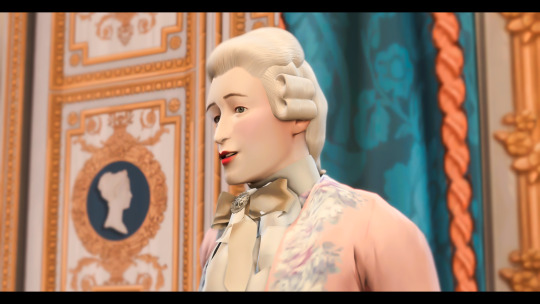
Philippe: A rare beauty, indeed, with a lot of character.

Napoléon V: Just the way we like them, eh Philippe?
Joachim: Are you jealous, Phil?
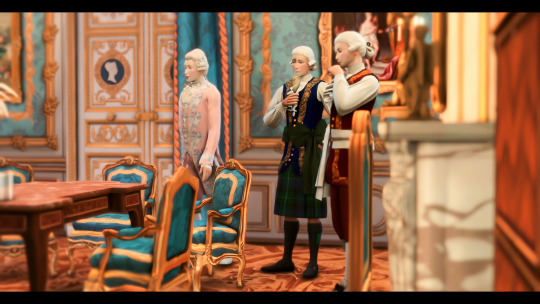
Philippe: Not at all, I'm happy for Louis
Grégoire: How does it feel, your last night as a free man?

Napoléon V: I must admit, I don't feel much difference. Is that a good sign?
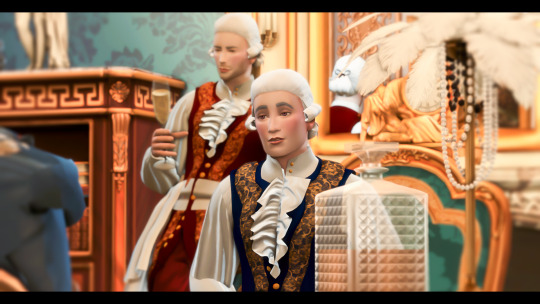
Oliver: Don't worry, Louis, you'll soon feel the difference

Joachim (laughs)
Napoléon V: It should go well with a bit of your whisky
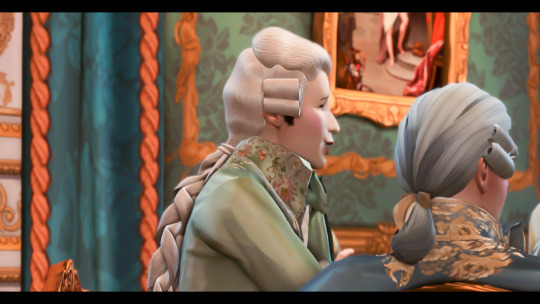
Joachim: Between the whisky and Charlotte, our Emperor's in no position to reign! Thank you Oliver!

Oliver: Well, I hope the Emperor is sure of himself. He'll soon be looking like a sober man with his soda, surrounded by tempting and delicious spirits

Napoléon V (teasing): What women are you talking about, my dear friend? Shall I tell my sister?
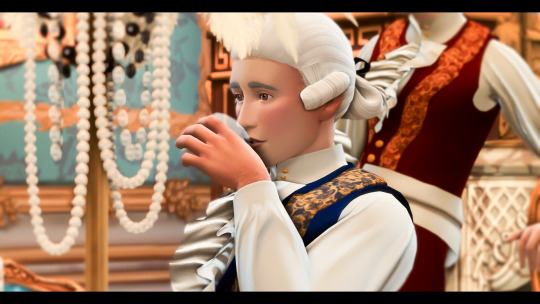
Oliver: I just want to point out that once you're married, you'll attract all the more women. Many want the benefits of a wife, without the official duties associated with it. And… In view of your ancestors, my theory seems to be borne out

Napoléon V: Really?

Grégoire: Charlotte can look after herself, don't worry Louis

Napoléon V (can't resist the whisky, drunk): Anyway, I don't need your help, I'm guided by Providence
Oliver: Come on

Napoléon V: I'm doing all this for Phil', poor chap, he nearly became Emperor of the French
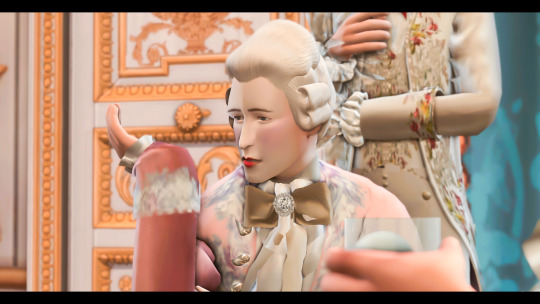
Philippe: Don't talk nonsense Louis
Joachim: It's nothing Phil', he's already completely drunk
Napoléon V: Shut up!
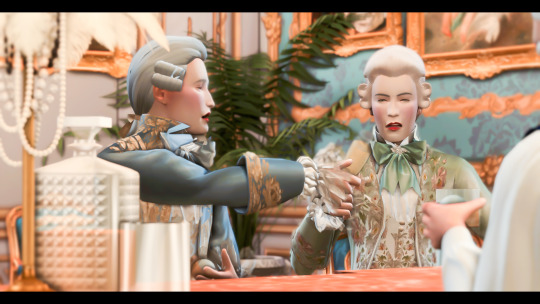
⚜ Le Cabinet Noir | Palais des Tuileries, 20 Prairial An 230
Beginning ▬ Previous ▬ Next
Napoléon V and a few friends celebrated his bachelor party at the palace. Joachim, his best friend and organizer, wanted to make it a rococo party, as he couldn't have fun outside the palace for security reasons.
(Thanks @officalroyalsofpierreland !)
⚜ Traduction française
Napoléon V et quelques proches fêtent son enterrement de vie de jeune homme au palais. Joachim, son meilleur ami et organisateur, a souhaité en faire une soirée rococo, à défaut de pouvoir s'amuser à l'extérieur du palais pour des raisons de sécurité.
Joachim : Oyez oyez! L'Empereur est de retour de Compiègne!
Aimery : Et en très bonne compagnie!
Napoléon V : Qui aurait pu résister à une telle beauté? Je veux bien y laisser ma main
Philippe : Une rare beauté, en effet, avec beaucoup de caractère
Napoléon V : Comme on les aime, n'est-ce pas Philippe?
Joachim : Tu es jaloux Phil' ?
Philippe : Nullement, je suis heureux pour Louis
Grégoire : Ca fait quoi, ta dernière nuit comme homme libre ?
Napoléon V : Je ne ressens pas trop de différence, je dois l'avouer. Est-ce bon signe ?
Oliver : Ne t'en fais pas Louis, tu sentiras rapidement la différence
Joachim (rigole)
Napoléon V : Ca devrait aller avec un peu de ton whisky
Joachim : Entre le whisky et Charlotte, notre Empereur est mal barré pour régner! Merci Oliver!
Oliver : Hé bien, j'espère que l'Empereur est sûr de lui. Il aura bientôt l'air d'un homme sobre avec son soda, entouré d'alcools tentants et délicieux
Napoléon V (taquine) : De quelles femmes parlez-vous, très cher ami? Dois-je en avertir ma soeur?
Oliver : Je veux simplement souligner qu'une fois marié, tu attireras d'autant plus de femmes. Beaucoup souhaitent les avantages d'une épouse, sans les devoirs officiels associés. Et... Au-vu de tes ancêtres, ma théorie semble se confirmer
Napoléon V : Vraiment ? Je ne souhaite pas faire de mal à Charlotte
Grégoire : Charlotte saura se défendre toute seule, ne t'en fais pas Louis
Napoléon V (ne résiste pas au whisky, bourré) : De toute façon, j'ai pas besoin de votre aide, je suis guidé par la Providence
Oliver : Allons donc
Napoléon V : Je fais tout ça pour Phil', le pauvre, il a failli être Empereur des Français
Philippe : Ne dis pas n'importe quoi Louis
Joachim : C'est rien Phil', il est déjà complètement saoul
Napoléon V : Ta gueule toi!
#simparte#ts4#ts4 royal#royal simblr#sims 4 royal#sim : louis#sims 4 fr#sims 4#gen 2#sim : joachim#sim : oliver#sim : aimery#sim : philippevictor#tuileries#le cabinet noir#weddingV#ts4 royal family#ts4 royal simblr#ts4 royalty#ts4 simblr#ts4 story#sims 4 royal story#sims 4 royalty
64 notes
·
View notes
Photo
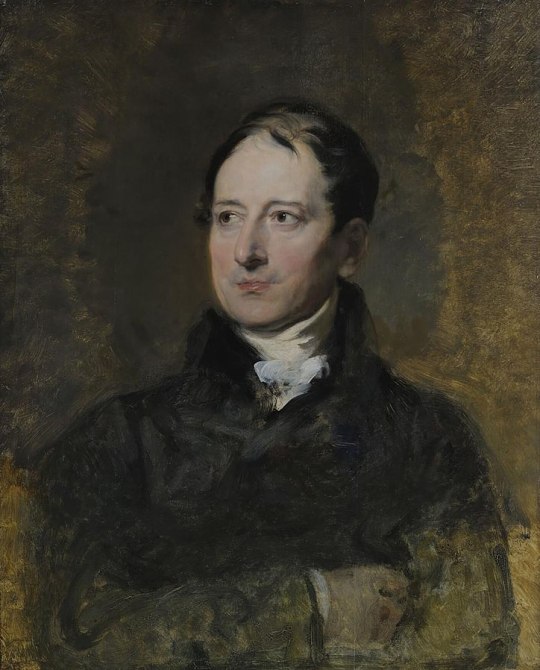
Thomas Lawrence - Portrait of François Pascal Simon, Baron Gérard (1770–1837) aged 54 - 1824
oil on canvas, height: 70 cm (27.5 in); width: 58 cm (22.8 in)
Palace of Versailles, Paris, France
Sir Thomas Lawrence PRA FRS (13 April 1769 – 7 January 1830) was a leading English portrait painter and the fourth president of the Royal Academy. Lawrence was a child prodigy. He was born in Bristol and began drawing in Devizes, where his father was an innkeeper at the Bear Hotel in the Market Square. At the age of ten, having moved to Bath, he was supporting his family with his pastel portraits. At eighteen he went to London and soon established his reputation as a portrait painter in oils, receiving his first royal commission, a portrait of Queen Charlotte, in 1790. He stayed at the top of his profession until his death, aged 60, in 1830.
Self-taught, he was a brilliant draughtsman and known for his gift of capturing a likeness, as well as his virtuoso handling of paint. He became an associate of the Royal Academy in 1791, a full member in 1794, and president in 1820. In 1810 he acquired the generous patronage of the Prince Regent, was sent abroad to paint portraits of allied leaders for the Waterloo chamber at Windsor Castle, and is particularly remembered as the Romantic portraitist of the Regency. Lawrence's love affairs were not happy (his tortuous relationships with Sally and Maria Siddons became the subject of several books) and, in spite of his success, he spent most of life deep in debt. He never married. At his death, Lawrence was the most fashionable portrait painter in Europe. His reputation waned during Victorian times, but has since been partially restored.
François Pascal Simon Gérard (4 May 1770 – 11 January 1837),[1] titled as Baron Gérard in 1809, was a prominent French painter. He was born in Rome, where his father occupied a post in the house of the French ambassador, and his mother was Italian. After he was made a baron of the Empire in 1809 by Emperor Napoleon, he was known formally as Baron Gérard.
François Gérard was born in Rome to J. S. Gérard and Cleria Matteï. At the age of twelve, Gérard obtained admission into the Pension du Roi in Paris. From the Pension, he passed to the studio of the sculptor Augustin Pajou, which he left at the end of two years for the studio of the history painter Nicolas-Guy Brenet, whom he quit almost immediately to place himself under Jacques-Louis David.
In 1789, he competed for the Prix de Rome, which was carried off by his comrade Girodet. In the following year (1790), he again presented himself, but the death of his father prevented the completion of his work and obliged him to accompany his mother to Rome. In 1791, he returned to Paris, but his poverty was so great that he was forced to forgo his studies in favor of employment which would bring in immediate profit. David at once availed himself of his help, and one of that master's most celebrated portraits, of Louis-Michel Le Pelletier de Saint-Fargeau, may owe much to the hand of Gérard. This painting was executed early in 1793, the year in which Gérard, at the request of David, was named a member of the revolutionary tribunal, from the fatal decisions of which he, however, invariably absented himself.
In 1794, he obtained the first prize in a competition, the subject of which was The Tenth of August, that is, the storming of the Tuileries Palace. Further stimulated by the successes of his rival and friend Girodet in the Salons of 1793 and 1794, Gérard (aided by Jean-Baptiste Isabey, the miniaturist) produced in 1795 his famous Bélisaire. In 1796, a portrait of his generous friend (conserved today in the Louvre) obtained undisputed success, and the money received from Isabey for these two works enabled Gérard to execute in 1797 his Psyche et l'Amour (illustration). At last, in 1799, his portrait of Madame Mère established his position as one of the foremost portrait-painters of the day.
In 1808, as many as eight (and in 1810, no less than fourteen) portraits by him were exhibited at the Salon, and these figures afford only an indication of the enormous numbers which he executed yearly. All of the leading figures of the Empire and of the Bourbon Restoration, and all of the most celebrated men and women of Europe, sat for Gérard. This extraordinary vogue was due partly to the charm of his manner and conversation, for his salon was as much frequented as his studio. Madame de Staël, George Canning, Talleyrand and the Duke of Wellington have all borne witness to the attraction of his society.
Rich and famous, Gérard was stung by remorse for earlier ambitions abandoned; at intervals, he had indeed striven with Girodet and other rivals to prove his strength at history painting, still a more prestigious genre than portraiture. His Bataille d'Austerlitz (1810) showed a breadth of invention and style which was even more conspicuous in L'Entrée d'Henri IV à Paris (at Versailles), the work with which in 1817 he paid homage to the returned Louis XVIII. After this date, Gérard declined, watching with impotent grief the progress of the Romantic school.
Loaded with honors – baron of the Empire in 1809, member of the Institut on 7 March 1812, officer of the Légion d'honneur, first painter to the king – he worked on, sad and discouraged. The revolution of 1830 added to his disquiet, and on 11 January 1837, after three days of fever, he died.
Gérard is best remembered for his portraits. The color of his paintings has suffered, but his drawings show in uninjured delicacy the purity of his line, and those of women are specially remarkable for a virginal simplicity and frankness of expression. His students included Heinrich Christoph Kolbe.
10 notes
·
View notes
Text
Top 6 Honeymoon Places For A Newly Married Couple In Summer
After the wedding is over, the most important thing is to find a place for the honeymoon. This article’s purpose is to provide the best place for lovebirds. Therefore, we have taken a survey to find the best honeymoon places.
Top 6 Honeymoon Places To Go In Summer
You will find the list interesting and valuable to making the decision for the honeymoon.
Bora Bora
The Bora Bora island is famous for its volcanos, jungles, aquamarine lagoon, and beaches. Author James Michener said that this is the most beautiful island in the world. Bora Bora island is also called the pearl of the pacific. There are sunny skies, luxurious resorts, friendly locals, and warm waters.
The US News and World Travel ranks this island at the top. You can stay at Blue Heaven Island, Sofitel Bora Bora Private Island, Bora Bora Eden Beach Hotel, and many more. There are matira beach, coral gardens, jungle safari, boat tours, shark feeding, lagoonarium, mount otemanu, vaitape, turtle center, spas, and mount pahia.
Bali
Bali sometimes refers to heaven. Bali is an island in Indonesia. Beautiful landscapes, volcanos, sandu shores, turquoise waters, pagodas, and many other interesting things exist. People from around the world visit Bali and enjoy themselves a lot in this place.
You can go there at almost any time of the year, but in summer it becomes more beautiful. You can stay at Samsara Ubud, Matahari Bunglow, Komaneka at Keramas Beach, and many more.
There are so many things to do. Here is the list- pura tirta empul, uluwatu temple, tanah lot temple, jimbaran, kuta, kintamai, sanur beach, nusa dua, tegallalang rice terrace, gunung kawi, waterbom bali, periuk bali cooking class, celebrity bike tours nusa penida and many more.
Paris
If I say honeymoon place, then Paris is one of the best places where you should go. This city is also called the city of light. There are many art collection and cuisine that needs to be acknowledged. The gentle river seine flows through the city. The main attractions are old churches, the block of Rococo, architecture, cascading trees, streetlamps, museums, and the most beautiful things are cafes.
If you have to choose one place to visit in Europe, Paris is at the top of the list. There are famous hotels like Le Bristol Paris, Four Seasons Hotel George V, La Reserve Paris, and many more. In addition, there are many things that you can do in Paris. The list is as follows.
Notre-dame cathedral, Musee du louvre, Eiffel tower, jardin des tuileries, le marais, sacred heart basilica of montmartre, musee d’Orsay, musee de I’Orangerie, pere-lachaise cemetery, palais garnier, luxembourg gardens, arc de triomphe, and many more.
Maldives
You must have heard about this island. There are luxurious resorts, blue waters, beaches, and beautiful sunsets. The scenic beauty of Maldives is so amazing that you don’t want to return to your regular life after going there. But, if you want your honeymoon to get relaxed, then the Maldives is your place.
You can stay at Vivanta by Taj Coral Reef, Maldives Vonmuli Resort, Huvafen Fushi, and many places. However, the Maldives is famous for its resorts, beaches, spas, and relaxation. But you can also visit Male, spas, hukuru miskiiy, fish market, and other places. Also, scuba diving is an attraction.
Maui
This island is not a large island, but it offers great wildlife, beaches, and historical culture. There are hula dancers, you can get booze and dance with them. There are golf fields, snorkels, and sea turtles. Maui has a total of five islands, most people stay in the southern part of it.
You can stay at Montage Kapalua Bay, Hotel Wailea, four seasons resort, and many more. In addition, you can visit hana road, haleakala national park, waianapanapa state park, pipiwai trail, makena beach, snorkel tour, kaanapali beach, iso valley state park, napili beach, and many more.
Fiji
Luxurious hotels, glittering sands, turquoise waters- Fiji is full of these things. This is one of the tropical gateways. There are a total of 333 islands to visit.
For adventurous and beach-loving people, Fiji is the ideal place. Fiji also ranks in second place when it comes to the best beaches in the world.
You can stay at Outrigger Fiji, Shangri-La’s Fijian, Wananavu, and many more resorts. There are so many things you can do in Fiji. There are the coral coast, mamanuca island, yasawas, navua river canoe, different villages, nadi tivua island and many more.
To Conclude
I hope this article will help you to decide on your honeymoon place. You can also check the bonus list.
St. Lucia
Amalfi Coast
Tahiti
Santorini
Kauai
Hawaii
Florence
Mauritius
So, what have you decided? Please let us know in the comment section.
Thank You.
2 notes
·
View notes
Text
December 7, 1815: The Execution of Marshal Ney
Until now, I have strictly followed same order for my translations as was found on the Sénat’s website. At this point I will skip over Marshal Ney’s trial, but will come back to it later on.
I posted an account of Marshal Ney’s final hours and of his execution a few weeks ago. This time, I am posting the account of Ney’s execution as it appears in the Sénat’s website. Some details will appear here that were not included in the contemporary report.
The execution on Thursday 7 December 1815
The morning of Thursday 7 December 1815 was damp and foggy.
Marshal Ney wore a blue frock coat, a black waistcoat, short breeches, and black silk stockings; he wore none of his many decorations, so there was no need to have him stripped of them.
Lieutenant-general d'Espinois entrusted General Count de Rochechouart with executing the judgment of the Chamber of Peers. The Marshal's departure from the Luxembourg Palace took place at 8.30 am.
Still showing a sense of humour as well as composure, the Marshal said to the curé as he got into the carriage: "Please get in, Monsieur le Curé. In a little while, I'll be going first."
Two lieutenants of the gendarmerie climbed in with them. The carriage was flanked by one hundred and thirty gendarmes forming a file on each side, followed by Rochechouart and La Rochejaquelein, by a company of veteran non-commissioned officers, by the firing squad, and by a squadron of the National Guard. Security measures were implemented all the way to the execution site, which was kept secret for fear of unrest.
The journey was very short: three hundred paces from the gate of Luxembourg Gardens. The site chosen for the execution was not the usual one, namely the Plaine de Grenelle, where Charles de La Bédoyère had been executed. This did surprise the Marshal.
The execution site was located between the entrance to the Avenue de l'Observatoire and the Luxembourg Gardens gate, along the wall of an enclosure. In today's Paris, the place of execution is located at the site of the Port-Royal RER station.
Ney handed the priest a snuffbox to be given to his wife, and a few louis for the poor of Saint-Sulpice. The troops were gathered and arranged into a square battalion. Some onlookers were also present: about two hundred people, including Peers of France, generals, officers from all nations, but mostly working-class people. Rochechouart appointed Monsieur de Saint-Bias, an officer of Piedmontese origin, to command the firing squad. Ney refused to kneel or to be blindfolded, declaring: "Do you not know that for twenty-five years I have been accustomed to facing cannonballs and bullets?" Remaining very calm and dignified, placing his hand over his heart, he said: "Frenchmen, I protest the judgement against me... my honour..."
He who, having spent his life on battlefields, had failed to be killed at Waterloo, died of eleven French bullets, six of them in the chest. A drum roll and cries of "Vive le Roi!" were then heard.
Rochechouart, commenting on the execution to La Rochejaquelein, said: "Here, my dear friend, is a great lesson in how to die well." At that moment, the Marshal's wife was still awaiting an audience with the King at the Tuileries, in hopes of securing a pardon. She obtained neither; the duke of Duras, first gentleman of the King, arrived to inform her, after the execution: "Madame, the audience you requested would now be pointless.”
The Marshal's body remained on the ground for fifteen minutes, during which time two incidents occurred: the first was caused by an Englishman on horseback who jumped over the corpse and then fled; the second, by a Russian general, in uniform and on horseback, who came to watch the execution of the Marshal.
His lawyer, Pierre-Nicolas Berryer, relates in his Souvenirs de M. Berryer that: "The wall, which was under construction, as well as its rubble, were soon covered with his blood; the eager crowd rushed to collect the smallest traces of it, with the same ardour as if it had been the pieces of the True Cross (...)".
The body was then taken to a nearby hospice, the Hospice de la Maternité, where it was entrusted to the Sisters of Charity. According to a police report, many personalities came to see the Marshal: Peers of France, generals, officers, ambassadors, etc. The next morning, his body was placed first within in a lead coffin, then the lead coffin into an oak coffin. He was then buried in the Père-Lachaise cemetery in a very simple grave,a slab on the ground.
Symbolically, this execution put a definitive end to the era of Revolution, the Empire and the Hundred Days period, but not to the memory of Marshal Ney.
The original French text can be found here: https://www.senat.fr/evenement/archives/D26/execution_et_rehabilitations/lexecution_le_jeudi_7_decembre_1815.html
Only eleven bullets struck Ney. I have read (I can’t remember where) that the twelfth bullet was found high on the wall, well above Ney’s head. Possibly at the same place I read about the above, I read that Ney coolly asked where it was the firing squad wished him to stand.
11 notes
·
View notes
Text
On 5 June 1832, young Victor Hugo was writing a play in the Tuileries Gardens when he heard the sound of gunfire. The park-keeper had to unlock the gate of the deserted gardens to let Hugo out. Instead of hurrying home, he followed the sounds through the empty streets, unaware that half of Paris had already fallen to the insurgents. When he was halfway down the alley, the grilles at either end were slammed shut. Hugo was surrounded by barricades and found shelter between some columns in the street, where all the shops were shuttered. Bullets flew past him in both directions.
The experience must have made a profound impression on him because he published LES MISERABLES 30 years later, immortalizing the June Rebellion of 1832. Within two months, it had sold 100,000 copies and was popular around the world. The West End musical based on it is the longest-running in the world, playing continuously for 32 years. More than 70 million people are estimated to have seen “Les Mis” on stage in 44 countries and 22 languages. Countless movies and miniseries have been based on the book.
What's my point? Generations of people have been moved by a story about people standing up for a better world, saw the pain of inequality and poverty and how marginalized people are easily labeled as 'criminals' for life, saw a holy man siding with the downtrodden and giving them shelter, even granting mercy to someone who stole his property out of desperation, saw how convicts existed as a modern form of slavery, saw people of all ages and classes fighting for those most in need, saw an obsessively principled policeman realizing that there is no way to reconcile the law with fairness and mercy, saw the National Guard firing on protesters and children, and the selfless sacrifice of one old man to protect the next generation. Victor Hugo made generations of people care about an attempted rebellion that was largely forgotten by history.
I hope it’s obvious to those who love Les Miserables which side of the current civil unrest is working toward a better tomorrow.
The musical includes the lyric, "Let others rise to take our place until the earth is free." That reflects the hope that the fight for freedom— for EVERYONE— will continue on and people will always strive to make the world better, safer, and more equal little by little. Protests and rebellions push back against the sense of hopelessness that nothing will ever change. But we can’t succumb to the myth of linear progress. We have to keep fighting, not only to move forward but to avoid losing the gains that have been made or denying the injustice that still exists.
There have already been some signs of positive change following the current protests. Unlike the June Rebellion of 1832, public support has spread widely, with protests occurring in all 50 states. Some city governments have already declared a desire to transfer funding from police departments to community organizations. The men responsible for George Floyd’s death have been charged. Cities are taking down Confederate monuments and renaming schools named after Confederate leaders. More and more people of all walks of life are speaking out and declaring that Black lives matter.
For the young people witnessing history now, who heard and saw protests on their streets, who were there at the protests, who recorded events on the streets of America in real time, who provided supplies for protesters, who experienced police brutality, who opened up your homes, you can be the ones to immortalize this struggle in art and literature for generations to come. You can keep the flame alive.
#les miserables#victor hugo#june rebellion#i dont post about politics on this account but this goes beyond politics#barricade day
340 notes
·
View notes